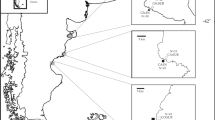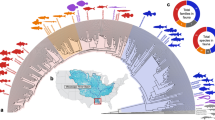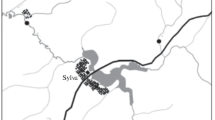Abstract
Morphometric studies are useful for delineating the shapes of various populations and species over geographical ranges and as evidence of regional differences in crustaceans. Hydrological fluctuations in a floodplain system modulate the dispersal and presence of decapods among habitats and constitute an important macrofactor that regulate other environmental variables and which could explain the richness, distribution and abundance of organisms that live in these systems. Morphological variations among populations of the freshwater prawn Macrobrachium borellii in a floodplain system at a microgeographical scale were studied using geometric morphometrics. Carapace structure was represented using 16 digitised landmarks. Allometry and sexual dimorphism was tested. Variation in shape was explored via Principal Component Analysis. Canonical Variate Analyses was applied to compare the differences in shape between species’ populations. The correlations and covariations among shapes and hydrometric level, current velocity, geographical location and hydrologic distances were analysed. The average carapace shape was different between sexes in all sites. Populations that were near each other in terms of hydrological distance had similar shapes, but all of the populations differed in shape from the farthest population. The environmental variables were not good predictors of the carapace shape. Instead, the shape was strongly related to the hydrologic distance and geographical location. The swimming characteristics of these prawns and their passive movements, together with the dynamics of a floodplain system, explain the low morphological variation between populations in this study. The dynamic characteristics of the system influence the dispersal of the prawns and allow populations to remain connected.






Similar content being viewed by others
References
Adams DC, Rohlf FJ, Slice DE (2004) Geometric morphometrics: ten years of progress following the “revolution”. Ital J Zool 71:5–16
Adams DC, Rohlf FJ, Slice DE (2013) A field comes of age: geometric morphometrics in the 21st century. Hystrix 24:7–14
Anastasiadou Ch, Leonardos ID (2008) Morphological variation among populations of Atyaephyra desmarestii (Millet, 1831) (Decapoda, Natantia, Atyidae) from freshwater habitats of north-western Greece. J Crustac Biol 28:240–247
Anastasiadou Ch, Liasko R, Leonardos ID (2009) Biometric analysis of lacustrine and riverine populations of Palaemonetes antennarius (H-Milne Edwards, 1837) (Crustacea, Decapoda, Palaemonidae) from north-western Greece. Limnologica 39:244–254
Anger K (2013) Neotropical Macrobrachium (Caridea: Palaemonidae): on the biology, origin, and radiation of freshwater-invading shrimp. J Crustac Biol 33:151–183
Arrington DA, Winemiller KO, Layman CA (2005) Community assembly at the patch scale in a species-rich tropical river. Oecologia 144:157–167
Barría EM, Sepúlveda RD, Jara CG (2011) Morphologic variation in Aegla Leach (Decapoda: Reptantia: Aeglidae) from central-southern Chile: interspecific differences, sexual dimorphism, and spatial segregation. J Crustac Biol 31:231–239
Bennetts RE, Nichols JD, Lebreton JD (2003) Methods for estimating dispersal probabilities and related parameters using marked animals. In: Clobert J, Danchin E, Dhondt AA, Nichols JD (eds) dispersal. Oxford University Press, Oxford, pp 3–17
Bissaro FG, Gomes JL, Madeira Di Beneditto AP (2012) Morphometric variation in the shape of the carapace of shrimp Xiphopenaeus kroyeri on the east coast of Brazil. J Mar Biol Assoc UK 93(03):683–691
Bock W (1999) Functional and evolutionary explanations in morphology. Neth J Zool 49(1):45–65
Bookstein FL (1991) Morphometric tools for landmark data. Cambridge University Press, Cambridge
Boschi EE (1981) Decapoda Natantia. Fauna de Agua Dulce de la República Argentina. FECIC 26:1–61
Chambers PA, Prepas EE, Hamilton HR, Bothwell ML (1991) Current velocity and its effect on aquatic macrophytes in flowing waters. Ecol Appl 1:249–257
Collins P (2001) Relative growth of the freshwater prawn Macrobrachium borellii (Nobili 1896) (Decapoda: Palaemonidae). Nauplius 9:53–60
Collins PA, Williner V, Giri F (2007) Littoral communities: Macrocrustaceans. In: Iriondo MH, Paggi JC, Parma MJ (eds) The middle Parana River, limnology of a subtropical wetland. Springer-Verlag, Berlin, pp 277–302
Corti M (1993) Geometric morphometrics: an extension of the revolution. Trends Ecol Evol 8:302–303
Darlington RB, Weinberg SL, Walberg HJ (1973) Canonical variate analysis and related techniques. Rev Educ Res 43:443–454
Fernandez D, Collins P (2002) Supervivencia de cangrejos en ambientes dulceacuícolas inestables. Nat Neotrop 33:81–84
García-Dávila CR, Magalhães C, Guerrero JCH (2005) Morphometric variability in populations of Palaemonetes spp. (Crustacea, Decapoda, Palaemonidae) from the Peruvian and Brazilian Amazon Basin. Iheringia Sér Zool 95:327–334
Giri F, Collins PA (2004) A geometric morphometric analysis of two sympatric species of the family Aeglidae (Crustacea, Decapoda, Anomura) from the La Plata basin. Ital J Zool 71:85–88
Giri F, Loy A (2008) Size and shape variation of two freshwater crabs in Argentinean Patagonia: the influence of sexual dimorphism, habitat, and species interactions. J Crustac Biol 28:37–45
Gomes LC, Bulla CK, Agostinho AA, Vasconcelos LP, Miranda LE (2012) Fish assemblage dynamics in a neotropical floodplain relative to aquatic macrophytes and the homogenizing effect of a flood pulse. Hydrobiologia 685:97–107
Hartnoll AL (1985) Growth, sexual maturity and reproductive output. In: Wenner AM (ed) Crustacean: factors in adult growth. Rotterdam AA, Balkema, pp 101–128
Huxley JS (1932) Problems of relative growth. The John Hopkins University Press, Baltimore (276 pp)
Idaszkin YL, Márquez F, Nocera AC (2013) Habitat-specific shape variation in the carapace of the crab Cyrtograpsus angulatus. J Zool 290:117–126
Jenkins KM, Boulton AJ (2003) Connectivity in a dryland river: short-term aquatic microinvertebrate recruitment following floodplain inundation. Ecology 84:2708–2723
José de Paggi S, Paggi JC (2007) Zooplancton. In: Iriondo MH, Paggi JC, Parma MJ (eds) The middle Parana River, limnology of a subtropical wetland. Springer-Verlag, Berlin, pp 229–245
Kapiris K, Thessalou-Legaki M (2001) Sex-related variability of rostrum morphometry of Aristeus antennatus (Decapoda: Aristeidae) from the Ionian Sea (Eastern Mediterranean, Greece). Hydrobiologia 449:123–130
Klingenberg CP (2011) MorphoJ: an integrated software package for geometric morphometrics. Mol Ecol Resour 11:353–357
Klingenberg CP (2013) Visualizations in geometric morphometrics: how to read and how to make graphs showing shape changes. Associazione Teriologica Italiana Hystrix. Ital J Mammal 24:15–24
Konan KM, Adépo-Gourène AB, Ouattaraa A, Nyingy WD, Gourène G (2010) Morphometric variation among male populations of freshwater shrimp Macrobrachium vollenhovenii Herklots, 1851 from Côte d’Ivoire Rivers. Fish Res 103:1–8
Mayora G, Devercelli M, Giri F (2013) Spatial variability of chlorophyll-a and abiotic variables in a river–floodplain system during different hydrological phases. Hydrobiologia 717:51–63
McGhee Jr GR (1999) Theoretical morphology: the concepts and its applications. Columbia University Press, New York (316 pp)
Montoya JV (2003) Freshwater shrimps of the genus Macrobrachium associated with roots of Eichhornia crassipes (Water Hyacinth) in the Orinoco Delta (Venezuela). Carib J Sci 39:155–159
Montoya JV, Roelke DL, Winemiller KO, Cotner JB, Snider JA (2006) Hydrological seasonality and benthic algal biomass in a neotropical floodplain river. J N Am Benthol Soc 25(1):157–170
Morrone JJ, Lopretto EC (1995) Parsimony analysis of endemicity of freshwater Decapoda (Crustacea: Maclacostraca) from southern South America. Neotropica 41:3–8
Neiff JJ, Poi de Neiff A, Casco S (2001) The effect of prolonged floods on Eichhornia crassipes growth in Paraná River floodplain lakes. Acta Limnol Bras 3:51–60
O’Reilly KM, Horn MH (2004) Phenotypic variation among populations of Atherinops affinis (Atherinopsidae) with insights from a geometric morphometric analysis. J Fish Biol 64:1117–1135
Olden JD, Hoffman AL, Monroe JB, Poff NL (2004) Movement behaviour and dynamics of an aquatic insect larva in a stream benthic landscape. Can J Zool 82:1135–1146
Poff NL, Ward JV (1992) Heterogeneous currents and algal resources mediate in situ foraging activity of a mobile stream grazer. Oikos 65:465–478
Poff NL, Allan JD, Bain MB, Karr JR, Prestegaard KL, Richter BD, Sparks RE, Stromberg JC (1997) The natural flow regime. BioSience 47:769–784
Ringuelet RA (1949) Camarones y cangrejos de la zona de Goya (Sergéstidos, Palamonidae y Trichodactylidae). Notas Mus La Plata Zool 14:79–109
Rohlf FJ (2006, 2007, 2013) Tps series. Department of Ecology and Evolution, State University of New York at Stony Brook, New York. http://life.bio.sunysb.edu/morph/
Rohlf FJ, Corti M (2000) The use of two-block partial least-squares to study covariation in shape. Syst Biol 49:740–753
Rohlf FJ, Marcus LF (1993) A revolution in morphometrics. Trends Ecol Evol 8:129–132
Rossi L, Cordoviola E, Parma MJ (2007) Fishes. In: Iriondo MH, Paggi JC, Parma MJ (eds) The middle Parana River, limnology of a subtropical wetland. Springer-Verlag, Berlin, pp 305–325
Rufino M, Abelló P, Yule AB (2006) Geographic and gender shape differences in the carapace of Liocarcinus depurator (Brachyura: Portunidae) using geometric morphometrics and the influence of a digitizing method. J Zool 269:458–465
Seilacher A (1970) Arbeitskonzept zur Konstruktionsmorphologie. Lethaia Oslo 3:393–396
Silva IC, Hawkins SJ, Paula J (2009) A comparison of population differentiation in two shore crab species with contrasting distribution along the Portuguese coast, using two morphological methodologies. Mar Freshw Res 60:833–844
Silva IC, Alves MJ, Paula J, Hawkins SJ (2010) Population differentiation of the shore crab Carcinus maenas (Brachyura: Portunidae) on the southwest English coast based on genetic and morphometric analyses. Sci Mar 74:435–444
Srijaya TC, Pradeep PJ, Mithun S, Hassan A, Shaharom F, Chatterji A (2010) A new record on the morphometric variations in the populations of Horseshoe Crab (Carcinoscorpius rotundicauda Latreille) obtained from two different ecological habitats of Peninsular Malaysia. Our Nat 8:204–211
Tzeng TD, Chiu CS, Yeh SY (2001) Morphometric variation in red-spot prawn (Metapenaeopsis barbata) in different geographic waters of Taiwan. Fish Res 53:211–217
Walker I, Ferreira MJN (1985) On the populations dynamics and ecology of the shrimp species (Crustacea, Decapoda, Natantia) in the Central Amazonian river Taruma-Mirim. Oecologia 66:264–270
Ward JV, Tockner K, Arscott DB, Claret C (2002) Riverine landscape diversity. Freshw Biol 47:517–539
Williner V, Giri F, Collins PA (2009) Los crustáceos decápodos dulceacuícolas en Argentina. FABICIB 13:107–125
Williner V, Giri F, Collins PA (2010) Metapopulations of Decapods in the floodplain of Parana River, South America. In: Alvarez MA (ed) Floodplains: physical geography, ecology and societal interactions. Nova Science Publication, New York, pp 179–199
Winemiller KO (2004) Floodplain river food webs: generalizations and implications for fisheries management. In: Welcomme RL, Petr T (eds) Proceedings of the second international symposium on the management of large rivers for fisheries. Food and Agriculture Organization & Mekong River Commission, FAO Regional Office for Asia and the Pacific, Bangkok, pp 285–309
Zimmermann G, Bosc P, Valade P, Cornette R, Améziane N, Debat V (2012) Geometric morphometrics of carapace of Macrobrachium australe (Crustacea: Palaemonidae) from Reunion Island. Acta Zool (Stockholm) 93:492–500
Acknowledgments
Thanks are given to Cristian Debonis and Esteban Creus for their field assistance and to Veronica Williner for his reviews and comments. This work was supported by grants from the Project PICT (Agencia Nacional de Promoción Científica y Tecnológica): “Diversidad biológica en ambientes dulceacuícolas a través del gradiente este-oeste de argentina: rotíferos, microcrustaceos y macrocrustaceos como grupos de estudio”. ANPCyT. Dr. Pablo A. Collins. 2007-01360. 01/01/2009-31/12/2011. CAI+D PI 2011, Title: ¿Adaptaciones y/o ajustes a ambientes acuáticos? Aspectos morfológicos, fisiológicos y genéticos en decápodos dulceacuícolas. 2013–2015.
Author information
Authors and Affiliations
Corresponding author
About this article
Cite this article
Torres, M.V., Giri, F. & Collins, P.A. Geometric morphometric analysis of the freshwater prawn Macrobrachium borellii (Decapoda: Palaemonidae) at a microgeographical scale in a floodplain system. Ecol Res 29, 959–968 (2014). https://doi.org/10.1007/s11284-014-1184-8
Received:
Accepted:
Published:
Issue Date:
DOI: https://doi.org/10.1007/s11284-014-1184-8




